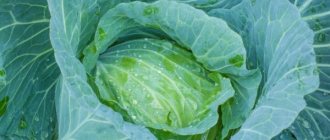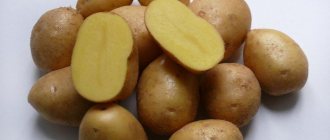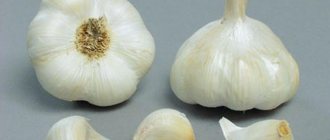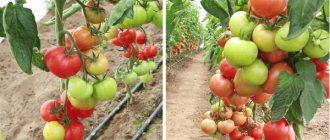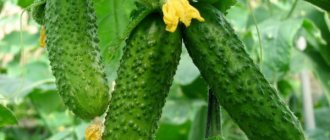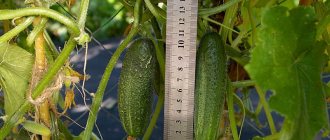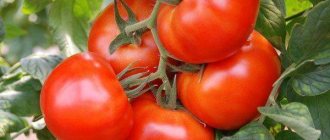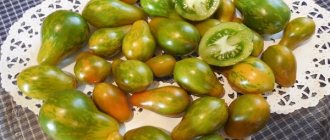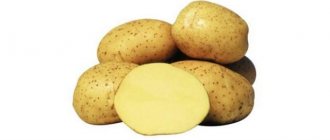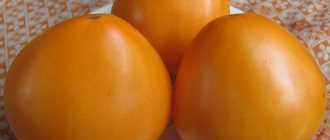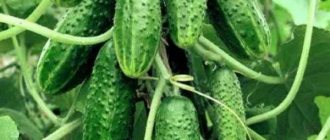Koza-Dereza cauliflower is considered an ideal variety for cultivation in temperate latitudes. Due to its adaptability to temperature changes, it ripens well in cooler northern regions, as well as in southern regions.
| Landing location | Ripening time | View | Purpose | Origin | Maturation period | Weight |
| Greenhouse, Open ground | Early ripening | White cabbage | Freezing, Cooking | Variety | 100 | 0,6-0,8 |
History of breeding of Koza-Dereza cauliflower
This variety of cauliflower is one of the latest achievements of modern Russian selection. The plant was bred in the early 2000s, within the walls of St. Petersburg. By 2007, the hybrid received official zoning and was included in the list of cultivated plants permitted for cultivation. The variety is approved for cultivation in any geographical latitude, but it develops best in the temperate and southern climatic zones.
Check out early, mid-early and late-season cauliflower varieties.
Reviews from gardeners
Girls, share the secrets of growing cauliflower. It doesn't work for me. It seems like I buy good hybrids. I planted Malimba, Koza-Dereza, White Excel, but I didn’t get a single head of cabbage. It would be more accurate to say that everything went into bloom. For 2 years I can’t adapt to her, I just take up space for her. I really love this cabbage and really want to grow it.
ElenaPr
For the 4th year now, only cabbage of the Koza-dereza variety has been producing heads; the other varieties have not set heads. I still don’t understand what’s the matter. I planted both my own seedlings and purchased ones... Goat... I manage to sow them in the ground in early May in a nursery, then I transplant them to a post. places. In principle, you can sow in a permanent place - germination is good, you don’t have to replant.
Alay
https://dacha.wcb.ru/lofiversion/index.php?t8215.html
I also really like the Koza Dereza cauliflower. It is productive, the head is white, large and dense.
Marinka
https://dacha.wcb.ru/lofiversion/index.php?t16606–200.html
I also planted different varieties, but the most problem-free is Koza-Dereza. I got it from Biotechnics.
Fox
Goat wolfberry is an excellent variety of cauliflower that is successfully grown in a wide variety of regions. It is good both in hot dishes, and in freezing, and in canning..
- Author: Maria Sukhorukikh
Rate this article:
- 5
- 4
- 3
- 2
- 1
(0 votes, average: 0 out of 5)
Share with your friends!
Description and characteristics
Goat-Dereza belongs to the traditional representatives of the Cruciferous family. It is an annual herbaceous plant used for its seasonal vegetable fruits. However, the variety has its own unique characteristics that distinguish it from related varieties and hybrids.
Appearance of cabbage
It is a medium-sized plant, about 40 cm high. The root system of this cabbage is fibrous, located in the upper layers of the soil. Its stem is cylindrical; at the top there are horizontally directed leaves with curved edges. The average leaf size is within 30 cm. The variety forms a fairly compact leaf rosette, with small, slightly transparent leaves.
Their color is rich, green tones, with a characteristic whitish waxy coating. A medium-tuberous head of soft white color is formed from a leaf rosette. It consists of small inflorescences, ranging in size from 3 to 15 cm. The fruit is medium in size, its shape is round, the tissues are dense to the touch, moderately moist, there is no friability at the head. The foliage of the top is minimal, the leaves practically do not cover it.
Ripening time and yield
Cauliflower of the Koza-Dereza variety is an early plant with a growing season of about 50–70 days. This makes it possible to grow it not only everywhere, but also to obtain harvests up to 3 times per season. The productivity of the variety is quite high, average yields reach 3 kg/1 m². Moreover, depending on the growing conditions, the weight of one head can vary from 600 to 800 g.
Did you know? Cauliflower appeared in Rus' in the 18th century. The culture was introduced and popularized by Empress Catherine II.
The best varieties and seeds for cauliflower
Cauliflower is one of the most valuable vegetable crops. Despite the fact that this is a very tender and tasty product, growing it is a troublesome task. The reason is that the plant requires special attention. To obtain a guaranteed harvest, it is necessary to water the soil correctly and in a timely manner, fertilize it, and provide access to light and heat.
Despite its capriciousness, cauliflower can be grown in unprotected soil conditions. In this case, it is allowed to use the following varieties:
- Movir 74 . Has early fruit ripening. Cabbage is characterized by its excellent taste. One fruit weighs 1.4 kg. The plant is very demanding when it comes to watering.
- Alpha . Hybrid, it is used for early harvesting. Ripe fruits can be collected already on the 60th day from the moment of seedling formation. The finished product has a smooth, dense and white surface.
- Consista . Reacts well to minor frosts. It bears fruit late. To do this you need to wait 90 days. The weight of one cabbage reaches up to 800 g.
- Autumn giant . Late ripening plant. Its growing season lasts 220 days. The weight of one ripe head reaches 2.5 kg.
- Yako . Suitable for growing in summer-autumn. Harvesting can take place on the 65th day. One fruit weighs 800 g.
For greenhouses
If you decide to grow cauliflower in a greenhouse, then there are already your own varieties. They cannot be used on unprotected soil, as they are not able to resist frost.
Guarantee
In a greenhouse, this plant allows you to get fruits early. The head matures in 16 days. Its color is cream or white. Able to resist cracking. The weight of one fruit reaches 900 g.
How to grow Brussels sprouts at home can be found in the article.
You can learn how to grow and care for broccoli in the article.
How Pekinskaya cabbage is grown and cared for is indicated here: //gidfermer.com/sadovodstvo/ovoshhevodstvo/pekinskaya-kapusta-vyrashhivanie.html
This video shows how to grow cabbage seedlings.
Goat - Dereza
This variety is characterized by the following distinctive features: the head is white, weighs 800 g, and ripens smoothly. The variety is used for growing crops in spring and summer.
Metelitsa F1
This hybrid is a domestic selection, perfectly adapted to negative climate conditions. A ripe fruit is characterized by a white, dense and rounded head. Product weight is 900 g.
It is one of the oldest. It was received back in 1953. The fruit is characterized by a white head and a dense consistency. The mass of cabbage reaches 700 g. It retains its presentation for a long time. It has excellent taste.
Early Gribovskaya 1355
Belongs to the group of the best in all regions of cultivation. The process of head maturation occurs in 14 days.
The finished product is white in color and there is no possibility of cracks. The weight of the product reaches 900 g. The plant can be grown in spring and summer.
Varieties for the Middle Zone and Moscow Region
Among the abundance of cauliflower varieties, breeders have developed those that are actively used by residents of central Russia and the Moscow region.
You can learn how to properly soak tomato seeds before planting from the article.
How Octopus cream f1 tomatoes are grown is indicated in this article.
How to grow tomato seedlings without picking can be found here: //gidfermer.com/sadovodstvo/ovoshhevodstvo/rassada/vyrashhivanie-rassady-tomatov-v-domashnix-usloviyax.html
How tomatoes are grown in a polycarbonate greenhouse can be seen in this article.
Express
Characterized by early harvest and small head size. The weight of one fruit is 350 g. The color of the product is white with a slight yellow tint.
The inflorescences have excellent development, the shape of the product is round. Harvesting can occur 55-60 days after the formation of seedlings.
Flora Blanca
This product will become a real decoration for your plot of land. The mass of one head is 1.2 kg, it is quite dense and has a white-yellowish color.
The head has excellent taste. Since this variety is considered mid-season, harvesting can occur on the 110th day. From 1 hectare of area you can harvest 25 tons of cauliflower.
For Siberia and the Urals
Today it has become possible to grow cauliflower even in harsh climates. What varieties should I plant? To get excellent results in Siberia and the Urals, you need to familiarize yourself with popular varieties.
White Castle
High yield, uniform formation of heads is observed. The product has excellent taste. Can be stored for 70 days. Resists autumn frosts and certain ailments. The weight of the product reaches 1.5 kg.
Summer resident
Designed for long-term storage of ripened fruits. The weight of one head will be 1 kg. Its color is white and its structure is dense.
Two sisters
The variety in question is characterized by high yield and excellent taste properties. The weight of the fetus reaches 1.5 kg. Can be used to prepare side dishes and frozen vegetable mixtures.
Emerald Cup
This product has an unusual dome-shaped head. Her color is light green. The weight of the fruit reaches 500 g. It is used exclusively in home cooking.
Yoke
Characterized by excellent taste properties. Can be used for long-term storage. Able to resist frost. The mass of the finished product is 1.6 kg.
purple ball
The fruit in question has a deep purple head. The variety is characterized by high yield and excellent taste. Suitable for long-term storage. Is immune to autumn frosts and some diseases. The variety is shown in this photo:
Early ripening
For those gardeners who can’t wait to get early fruits, they should turn their attention to early-ripening varieties of cauliflower.
When planting this variety, harvesting can occur on the 120th day. From 10 m2 you can get 30-40 kg of cauliflower. The maturation of the heads occurs simultaneously.
They all have almost the same size, density and round shape. The weight of the product is 2 kg. The heads can be used in cooking when preparing fresh salads.
Golden hectare 1432
The ripening period occurs 110-130 days after the formation of seedlings. The heads also ripen very quickly. The variety in question is not characterized by cracking.
The heads are presented in white color, have a dense structure, rounded shape. The weight of one fruit reaches 3 kg.
Ditmarskaya early
This variety allows you to get a harvest already in 50-70 days. It is characterized by good yield and excellent presentation during long-term storage.
The shape of the head is round, slightly flattened. She weighs 1.5 kg. From 10 m2 it is possible to obtain 30-40 kg of harvest.
Dutch
Today, the Dutch varieties Andes and Sierra are actively grown. These plants have high yields and medium maturity. The head has a dense structure and snow-white color. Seeds can be planted 2 times per season.
Also included in this group is the Goodman variety. It is of early maturity. The head is dense and reliably protected. Can be used fresh. Product weight 1.5 kg.
Colemen - this variety of Dutch selection attracts all gardeners with its friendly ripening. The head has reliable protection, so it does not need shading. The weight of the fruit reaches 2 kg.
Latemen variety actively resists negative climate conditions. The head has reliable protection, a dense structure, and a white color. The weight of the fetus is 2.5 kg. In the photo - the Latemen variety:
Advantages and disadvantages of the variety
- Main advantages of the variety:
- high productivity;
- friendly formation of inflorescences and maturation;
- excellent taste characteristics of the crop;
- guaranteed stability of yield;
- frost resistance;
- good resistance to major crop diseases;
- almost ideal fruit shape;
- good shelf life and transportability;
- the yield of commercial products is about 90%.
This cabbage also has minor drawbacks. First of all, the plant is considered quite whimsical, and therefore requires painstaking care and daily attention. Cabbage also requires bleaching; for this, during its growth, you need to build a small dome from the top leaves. This always requires additional labor and a lot of time.
Rules for growing the variety
There are two ways to grow cauliflower: seedlings and non-seedlings. Both of them provide the opportunity to get good seedlings, but it is best to grow the crop using seedlings. This will help avoid the death of young plants, and will also provide them with an optimal microclimate for successful fruiting.
Preparing seeds for sowing
The preparation of cauliflower seeds is no different from the preparatory measures used for sowing material of other crops. First, the seeds should be checked for quality; to do this, they are filled with clean water at room temperature. Seeds that float to the surface of the water film are discarded; they do not contain a healthy sprout, as well as the nutrients necessary for germination.
Important! For sowing, it is best to select the largest seeds, because only they can provide large and healthy seedlings that can further actively develop and bear fruit.
After this, the seed must be activated; this is done by heating it in warm water. The seeds are dipped in clean water at a temperature of about +50°C for 20 minutes, and then cooled sharply in water at a temperature of +18...+20°C. Immediately before planting, the seeds are also sterilized. This is done by soaking in bactericidal solutions. Most often, the procedure is performed using a 70% alcohol solution (about 10 minutes) or a 2% potassium permanganate solution (20–30 minutes).
Further care of seedlings
Seeds are sown in common or individual containers in a row, while the depth of the seeds should not exceed 0.5 cm, row spacing should be maintained at least 3 cm. Keep the sown containers in a well-lit place at a temperature of about +20°C, ensuring moderate soil moisture . Approximately on the 5th day after sowing, seedlings appear, after which the seedlings are transferred to a cool place with a temperature of +6...+8°C for 5 days.
Then she should be provided with a daytime temperature of +15...+18°C, with a nighttime decrease to +8°C. This is the main requirement when growing cauliflower, otherwise it will not form fragrant heads. At the same time, water the soil moderately, avoiding sudden drying out and waterlogging. Plants are provided with good lighting, with diffused light. The crop is very demanding of nutrients, so feeding seedlings is mandatory.
Find out what to do if your cauliflower won't set.
The first time it is done after the plants reach the 3-leaf phase; for this, the containers are watered with a solution of 2% boric acid (2 g/1 l of water). When the phase of 4 leaves occurs, the seedlings are fed with a solution of ammonium molybdate, at a rate of 5 g/10 l of water. A few days before planting cabbage in open soil, it is fertilized with phosphorus and potassium compounds. To do this, use a complex mixture consisting of superphosphate (2 g/1 l of water) and potassium chloride (3 g/1 l of water).
Preparing the site and soil
Cauliflower loves well-fertilized soil, so the site is prepared about 2 weeks before transplanting the plants. First of all, the soil is cleared of plant debris and other debris, and then thoroughly plowed to a depth of about 30 cm. After this, the area is fertilized with any organic fertilizer. Rotted manure or a mixture of equal parts of humus, peat and compost is best suited for this.
Fertilizers are applied at the rate of 10 kg/1 m², after which the area under the beds should be plowed well again. During site preparation, it is also necessary to take into account previous crops. Cauliflower grows and bears fruit the worst after other cruciferous vegetables, carrots, beets, radishes and daikon. In this case, cucumber, onion and legumes are considered the best predecessors. When planting beds, you should also take into account your neighbors: the crop does not withstand proximity to strawberries, beans and tomatoes.
Transplanting seedlings into open ground
Planting of seedlings into open soil is carried out approximately 30 days after sowing the seeds. When grown in temperate zones, the best period for this is from early to late April. Pick cabbage only in the late evening, but in cloudy weather this can be done throughout the day.
Plants are planted in rows according to a 50x25 cm pattern, to a depth of about 5–7 cm. About 1 cup of crushed wood ash is added to each plant. It will be the best source of important elements that will help plants actively take root in the garden. At the end of the procedure, the area is well watered.
Important! After planting the sprouts for 2
–
It should be shaded for 3 days. This will help the seedlings avoid the negative effects of direct sunlight and improve their rooting.
The best varieties of cauliflower for open ground
Cauliflower is highly valued for its vitamin composition and excellent taste. Beginning gardeners are advised to read the description of all varieties of this crop in order to choose the right vegetables for cultivation in their gardens, taking into account the climate and other external factors.
This article makes a selection of the best varieties of crops, each of which has its own advantages. Everyone will be able to choose options for their garden, depending on their preferences. Here are the most delicious varieties, the earliest, and the most productive.
The quality of agricultural technology makes adjustments to the taste and fertility of cauliflower, so when caring for the garden bed, you should not ignore the basic rules:
- watering;
- feeding;
- loosening and weeding;
- treatment.
Feeding cauliflower
It is also important to harvest cabbage in a timely manner, since an overripe vegetable or green one does not have the full valuable qualities or ideal taste.
In order to be able to harvest crops throughout the summer, it is recommended to plant varieties with different ripening periods on the plot. Then you can enjoy the different taste of the vegetable and make preparations for the winter.
Cauliflower is considered capricious, but the best varieties selected are resistant to adverse weather conditions, typical diseases, and have excellent taste. With proper agricultural technology, gardeners are always blessed with a generous harvest. Vegetables are used both fresh and for winter preparations. During long-term storage, they do not lose their taste and commercial characteristics.
The plant is distinguished by a long period of fruiting, the ripening period begins 80-100 days after transferring the seedlings to the garden bed. The white round head with a slight flatness weighs up to 1 kg. The chemical composition of the vegetable contains high levels of sugar and ascorbic acid, due to which the inflorescence has interesting notes of taste.
The leaves shelter the developing head from the scorching rays of the sun, which allows you to get clean fruits. The size of the summer resident variety is small, so the planting density is 3-5 plants per 1 m2 (the distance between the bushes is 50 cm). The transfer of seedlings to the garden bed is planned for late May - early June.
The vegetable tolerates transportation well and retains its valuable properties for a long time, subject to storage conditions.
Snowball
Cabbage fully lives up to its name; mature inflorescences are snow-white in color, although they are small in size. The weight of one copy does not exceed 850 grams. High yields are achieved thanks to dense planting, because the bush is compact and does not require space for branching. The best variety among early ripening varieties has long been popular among gardeners.
The lion's share of this success lies in the plant's resistance to typical diseases. The fast ripening period makes it possible to obtain two harvests per season in the black soil zone; no more than 60-65 days pass from the moment the seedlings are planted to full ripening. The seedlings quickly take root in a new place and mature together . The holes for seedlings are arranged according to the following pattern: 50x50, 50x70 cm.
Cauliflower summer resident Variety Movir Cauliflower snow globe
Movir
A hybrid resistant to cold and high temperatures, which, thanks to its fast ripening period, allows you to harvest 2 crops per season, even in central Russia. The round or rounded-flattened inflorescence is white, sometimes with a cream tint. Weight – from 500 to 1200 grams.
The plant cannot boast of special immunity to diseases and pests, but the taste of the vegetable will pleasantly surprise even a gourmet. When seeds are planted, germination rates are observed.
You can safely get fruits as early as June if you sow in the second half of February and cover the transferred seedlings with film, protecting them from possible spring frosts.
The location of the holes in the bed is planned with an interval of 50 cm in the row and from 60 cm in the row spacing, the transfer of seedlings is planned for the period from May 25 to June 10. The plant responds well to nitrogen-potassium fertilizers and other fertilizers.
The inflorescence is white with a yellowish tint and occupies a leading position in taste among early ripening plants (the growing season does not exceed 62 days).
Dense planting of compact plants (the interval between bushes is 25-35 cm, row spacing is 60-70 cm) allows you to harvest a good harvest, given that the weight of the head does not exceed half a kilogram. Cabbage is vulnerable to pests, but is resistant to no less dangerous bacteriosis.
Preventive treatments and regular weeding will help prevent the invasion of parasites. The transfer of seedlings to the garden bed is planned for early May. A film shelter will provide protection from possible night frosts.
A compact, erect plant with a white head that has a yellowish and sometimes reddish tint. The weight of the inflorescence reaches 800 grams, but with proper agricultural technology it is possible to grow heads over 2 kg. After planting the seedlings, the fruits ripen in 53-70 days.
Seedlings are distinguished by good germination and friendly development. Shoots can be planted both in spring (second half of April) and in summer (until mid-July). Holes for seedlings are planned according to the following scheme: 4 plants per 1 m2.
Goat wolf cabbage is very demanding on the composition of the soil, so when cultivating the crop it is necessary to fertilize the bed and feed the bushes.
Cabbage goat dereza
flora blanca
Shoots planted in the garden ripen in 109-112 days. The inflorescences have a round, slightly flattened shape, white with a cream tint. The weight of an average-sized specimen reaches 1.2 kg.
The fruit is well covered with leaves, which protects it from scorching sun rays, which can cause the formation of dark spots and bitterness in taste. Both germination and ripening occur simultaneously, so harvesting does not take a long time. The holes for seedlings are arranged according to the following pattern: 50x50, 50x70 cm.
Cabbage is tolerant to bacteriosis and frost, and retains its quality for a long time if properly stored.
White beauty
It is a high-yielding species due to its large, round, white head. In addition, the plant has a fast ripening period; signs of ripeness are observed 55-65 days after planting the seedlings in an open garden bed. The weight of the inflorescence reaches 800-1200 grams.
A feature of the culture is considered to be low resistance to temperature changes and pests. It is recommended to cover the transferred seedlings with film material and timely carry out preventive treatments against parasites.
Cabbage retains its dense structure and valuable properties well during transportation and storage. Even freezing does not spoil the presentation.
Among the late-ripening varieties, this variety is considered the most productive. The credit for this goes to the breeders who developed a hybrid that is resistant to diseases and adverse weather conditions. Due to the formation of a large inflorescence (weight from 2 to 3 kg), the plant needs regular soil fertilization.
The large leaves provide shade to the head, allowing the cabbage to withstand the heat. The vegetable is harvested 75-80 days after transferring the seedlings to an open bed. Young shoots, although capricious, quickly adapt to the new environment.
The holes are lined up according to the following pattern: the interval between bushes is at least 70 cm, the row spacing is from 80 cm.
Cortes variety
Amerigo
The snow-white massive heads ripen 74-80 days after the seedlings are transferred to open ground. One copy weighs 2-2.5 kg. Unlike other varieties, Amerigo has good immunity, which allows it to resist viral infections and pests.
The heads can ripen until frost; cold resistance allows them to maintain commercial quality and delicate taste. Intensive growth requires regular feeding. A special feature of the variety is its large leaves, which create shade for the inflorescences, saving them from the scorching rays of the sun.
Transferring the seedlings to the garden bed is planned for the second half of May-early June. The holes are lined up according to the following pattern: the interval between bushes is 70-80 cm, the row spacing is 70 cm.
Growing cauliflower requires a little more attention and effort, since the plant is less protected from diseases and pests. But how nice it is to pick beautiful inflorescences from the beds and delight your loved ones with delicious culinary dishes or winter preparations.
Source: https://profermu.com/ogorod/kapusta/tsvetnaya.html
Basic rules for caring for cabbage
The key to successfully growing any vegetable crop is to create an optimal microclimate on the site. To achieve this, they use a specific system for caring for planted seedlings, which allows them to achieve the first successes after just a few weeks. It involves a skillful combination of regular watering, fertilizing, as well as qualified soil care.
Rules for watering and fertilizing
Koza-Dereza is undemanding to the amount of moisture, but periodic moistening is very important for the variety. Without this, you cannot achieve fragrant heads with a bright and memorable taste. The beds should be moistened no more than once a week; during periods of drought, the frequency of the procedure can be doubled, but the soil must always dry out. Use only clean and settled water for irrigation, heated to ambient temperature.
In open soil, the crop is fed only 3 times per season. The first time the beds are fertilized 10–14 days after planting the seedlings, the following fertilizing is alternately applied at intervals of 14–20 days. If possible, the amount of fertilizing can be increased, but it is done before the heads are set, otherwise nitrates and other harmful substances may accumulate in the fruits.
You will be interested to know what to do if the cauliflower blooms.
The following fertilizer options are considered effective for fertilizing beds:
- cow manure solution (1:10);
- liquid bird droppings (1:15);
- mineral mixture of 50 g superphosphate, 20 g urea and 20 g potassium chloride (per 10 l of water/1–2 m²).
Loosening and weeding
Since most of the root system of cauliflower is located in the upper horizons of the soil, the crop reacts negatively to loosening the soil, so it is recommended to neglect the procedure, otherwise there is a possibility of damaging the plant roots. For the same purpose, weeding of beds is minimized, doing it only as needed. You can almost completely avoid loosening and weeding using mulching.
The procedure not only has a detrimental effect on weeds, but also creates the necessary microclimate in the soil. Mulch the beds with peat, humus, sawdust, conifer needles, seed husks, etc. The mulch is densely covered with mulch around the trunk of each plant, with a layer of about 5–10 cm. The mulch layer is renewed periodically, this is especially important after strong and heavy rains, when part of the protective layer is washed off.
Did you know? The homeland of cauliflower is considered to be Syria. That is why, until the 18th century. in the chronicles the plant was known as “Syrian cabbage”.
Characteristics of the Goat-dereza variety
The State Variety Commission gives this variety of early-ripening cauliflower, suitable for home cooking, a very restrained description. Goat wolfberry has an erect rosette with medium-sized leaves. They partially cover the heads and prevent them from darkening too much in the sun. The heads are dense, round, almost white in color, with good taste. The average weight is 0.8 kg, and the yield per square meter of bed with a recommended planting pattern of 50 cm x 40 cm is about 3.2 kg.
You can grow goat wolfberry from spring to autumn, shifting the time of planting seedlings into the garden bed. Cabbage planted in the ground in March-April will ripen in 57-70 days, from April to June - in 51-62 days, in June-July - in 52-68 days.
Seeds of Goat-wolfberry produce friendly, strong shoots that can easily withstand picking and replanting operations. In the garden, this cauliflower is not afraid of slight frosts and diseases inherent in this type of plant.
Koza-dereza cauliflower tolerates picking well
Hardened seedlings can withstand return frosts down to minus 3–4 °C. To prepare young plants for weather surprises, a week before planting in the ground, the seedlings are taken out into the open air and left in a shaded place for one and a half to two hours. In the following days, the hardening time of the plants is extended daily by 3–4 hours and the location of its placement is gradually changed to a sunnier one.
Timely hardening of seedlings will help Koza-dereza cabbage withstand return frosts
At the same time, the ripening heads of the Goat-wolfberry practically do not require shelter and do not begin to “curl”. This cauliflower can be used to prepare various dishes for adults and children. Winter preparations in the form of freezing and home canning are also good.
Koza-dereza cabbage makes tasty and healthy dishes
Video: cabbage harvest demonstration
Pest and disease control
Damage to cauliflower by all kinds of diseases and pests is not uncommon. Every vegetable grower encounters this problem, so before planting a crop, you should definitely familiarize yourself with ways to combat problems. This is the only way to protect yourself from low productivity of beds, as well as from the death of plantings.
The main diseases affecting Koza-Dereza cabbage:
| Name | The most effective drug for treatment |
| Alternaria blight | Bordeaux mixture, colloidal sulfur, 2% copper sulfate solution |
| Ring spot | Any complex fungicide |
| Wet rot | 0.4% solution of colloidal sulfur |
| Vascular bacteriosis | "Planriz", "Trichodermin" |
| Fusarium | "Fitosporin", "Fundazol" |
| Downy mildew | "Ridomil Gold" |
The main pests of cabbage are considered to be cutworm and cabbage white moth caterpillars, as well as the cabbage fly. Developing on the surface of the plant, they eat its foliage, which leads to inhibition of cabbage growth, as well as a decrease in its productivity.
Caterpillars are combated by spraying the beds with Enterobacterin or any other interchangeable product. You can eliminate the fly using the drug “Karbofos”; its solution is generously watered around the tree trunks of plants, as well as between the rows.
Agricultural technology
Sowing seeds for seedlings occurs in April. The plant reaches its permanent location in May. This occurs 40 days after germination. Cabbage does not like being thickened; it needs to be given more free space. It is worth sticking to the 50x40 cm pattern.
Sometimes summer residents try not to sow all the cabbage at once, but do it at some intervals. It turns out that fresh heads delight them all summer.
For Koza-Dereza cauliflower, timely watering is important. The soil should be moistened especially during the formation of heads. But overwatering should not be allowed.
With slow growth and the presence of pale leaves, it is necessary to fertilize with nitrogen fertilizers. It also happens that the plant gains excessive growth of tops, then phosphorus compounds are needed.
Hilling will strengthen the stem of the plant and give it a stable position.
Loosening will prevent weed growth and provide oxygen to the roots.
When exposed to sunlight, cabbage turns yellow, crumbles and begins to bloom. Shading is required.
The plant loves fertile soil.
Koza-Dereza cauliflower is quite thermophilic. Growing is optimal at a temperature of 18-20°C. Increasing it ensures that the seedlings are stretched, the heads are small and quickly crumble.
Features of harvesting and storage
Harvesting is carried out immediately after the heads reach technical ripeness, often requiring 50 to 70 days after the appearance of the first shoots. Determining the ripeness of the crop is quite simple: the heads acquire a rich white color and density, and their diameter increases to 10 cm. Cut the crop carefully, leaving at least 2-4 leaves on the rosette. If several side shoots have developed on the bush, then 2–3 of the strongest ones are left (in the future, young heads will appear on them).
We recommend that you learn how to properly cut cauliflower and store it.
Store cabbage in wooden or plastic open containers in cool rooms. The best place for this is a refrigerator, cellar or basement, where the crop can be provided with a temperature of no higher than +10°C, as well as moderate air humidity. In such conditions, the crop can be stored for up to 2 months after harvest. Freezing is used to extend shelf life. In this case, the heads are first dipped in boiling water for 5 minutes. This will allow cabbage to be preserved for 12 months after harvest.
The Goat-Dereza harvest is distinguished by its universal purpose. It can be used to prepare fresh salads, side dishes and soups. Cabbage can be boiled, stewed and fried, including in batter or breadcrumbs. In this case, it will be an ideal complement to meat, fish or other vegetables. Cabbage is often used as a filling for pies, and also as a base for making pickles. The Koza-Dereza variety is distinguished by its early ripening, productivity and excellent production characteristics.
Find out if cauliflower leaves are edible.
This plant is perfectly prepared for cultivation in hot and moderately cold regions, so it can be successfully used for home and industrial vegetable growing in various climatic zones. However, to obtain a high yield, the crop should be provided with daily care, as well as a special microclimate should be created in the garden bed.
A little history
The first mentions of cauliflower were in the 11th century. It was called Syrian because it was grown by the Arabs. It had small white-green fruits. The taste is bitter. Even at that time, the benefits of this product were discovered. Ali ibn Sina himself recommended consuming this vegetable in winter to strengthen the immune system.
A century later, the medicinal vegetable came to Europe. It was the 12th century that was characterized by the emergence of the first varieties bred by Europeans. Back then cabbage was not given much importance.
Photo of Koza-dereza cabbage
Three centuries later, the vegetable began to be taken more seriously, and then the first European varieties began to appear. For Russian people, cauliflower was a luxury. Only wealthy people could afford it.
It was impossible to grow cauliflower on Russian soil due to the climate. Later, Russian breeders obtained varieties that could grow under the northern sun. Among them is Koza-Dereza cabbage.
This healing vegetable has not received proper distribution in Russian garden beds. Until now, the majority are in favor of white cabbage. Abroad, cauliflower is very popular. For example, in Europe it is grown 10 times more.
